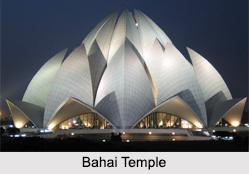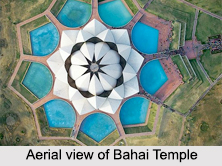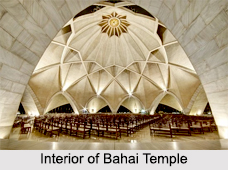 The Lotus Temple is also famous as the "Bahai Temple" or "Bahai Mashriqul-Adhkar Temple" and is one of the best architectural wonders in the county. Similar in style to the Sydney opera house, this is a white marble and concrete structure in the shape of a lotus flower. This is the Asian headquarters of the Bahai faith and a circular temple that is open to all. It looks spectacular particularly in evening when it is floodlit.
The Lotus Temple is also famous as the "Bahai Temple" or "Bahai Mashriqul-Adhkar Temple" and is one of the best architectural wonders in the county. Similar in style to the Sydney opera house, this is a white marble and concrete structure in the shape of a lotus flower. This is the Asian headquarters of the Bahai faith and a circular temple that is open to all. It looks spectacular particularly in evening when it is floodlit.
With the dawning of every new day, an ever-rising tide of visitors surges to its doorsteps to savour its beauty and bask in its serenely spiritual atmosphere. Now it is one of the most visited edifices in India. From its high-perched pedestal, this `Lotus` stands out over vast green lawns and avenues that cover 26 acres of land. It seems as if the Lotus is giving its compassionate glance over the lush green lawn.
The temple has etched itself on the consciousness of the city`s inhabitants, revolutionizing the concept of worship. Shaped like a half opened Lotus flower, this temple is made of marble, cement, dolomite and sand. This is the "Bahai Mashriqul-Adhkar Temple", better known as the "Lotus Temple". It is open to all faiths and is an ideal place for meditation and obtaining peace and tranquillity. It serves as the Mother Temple of the Indian subcontinent.
Location of Bahai Temple
The Bahai Temple is situated in Kalkaji, south of Delhi.
History of the Bahai Temple
 The construction of the Bahai House of Worship of Bahapur was a significant chapter in the making of Bahai history in the Indian sub-continent. Bahai have endeavoured to their utmost to build houses of worship as beautiful and distinctive as possible. They have been inspired by writings of Baha`u`llah and His son Abdu`l- Bahai and by the noble example set by Shoghi Effendi, the Guardian of the Bahai Faith, who initiated the process by rising up the magnificent edifices at the World Centre of the Bahai religion in Haifa, Israel.
The construction of the Bahai House of Worship of Bahapur was a significant chapter in the making of Bahai history in the Indian sub-continent. Bahai have endeavoured to their utmost to build houses of worship as beautiful and distinctive as possible. They have been inspired by writings of Baha`u`llah and His son Abdu`l- Bahai and by the noble example set by Shoghi Effendi, the Guardian of the Bahai Faith, who initiated the process by rising up the magnificent edifices at the World Centre of the Bahai religion in Haifa, Israel.
The blossoming of the `Lotus of Bahapur` further perpetuated this flowering of Bahai architecture. Bahai houses of worship are open to all people. Although their architectural styles differ widely, the nine sides and central dome common to all of them symbolize at once the diversity of the human race and its essential oneness. Devotional programs are simple, consisting of prayers, meditations and the reading of selections from the sacred scriptures of the Bahai Faith and other world religions.
Significance of the Lotus of Bahai Temple
The Lotus has a symbolic value in India and it is seen as a symbol of beauty and purity. Since it is located above the stagnated water, it is seen to be pure, representing the manifestation of God. This ancient Indian symbol was adopted to create a design of ethereal beauty and apparent simplicity, contradicting the complex geometry underlying its execution in concrete form. Thus, the temple proves to be a remarkable fusion of ancient concept, modern engineering skill, and architectural inspiration.
Sites and Architecture of Bahai Temple
The Lotus Temple is one of the 100 canonical works of this century, a powerful icon of great beauty that goes beyond its pure function of serving as a congregation space to become an important architectural symbol. Fariborz Sahba, Canadian architect of Iranian origin, spent 10 years in designing and project management, and with the help of a team of about 800 engineers, technicians, artisans and workers brought to realisation one of the most complicated constructions in the world.
It provides one of the rare exceptions with its remarkable fusion of ancient concept, modem engineering skill, and architectural inspiration, making it the focus of attention amongst engineers and architects the world over. In the absence of sophisticated equipment, the extremely complex design called for the highest order of engineering ingenuity to be implemented by means of traditional workmanship.
The structure of the House is composed of three ranks of nine petals; in the Bahai faith, the number nine represents the highest digit and unity. The nine pools on the elevated platform signify the green leaves of the lotus - and cool the stark, elegant interior. Each petal was springing from a podium elevating the building above the surrounding plain. The lotus shaped structure has two layers: nine white marble-covered petals that point to heaven, and nine petals that conceal the portals. The first two ranks curve inward, embracing the inner dome; the third layer curves outward to form canopies over the nine entrances.
The petals, constructed of reinforced white concrete cast in place, are clad in white marble panels, performed to surface profiles and patterns related to the geometry. Nine arches that provide the main support for the superstructure ring the central hall. Nine reflecting pools surround the building on the outside, their form suggesting the green leaves of the lotus flower. Translating the geometry of the design, in which there are virtually no straight lines, into the actual structure presented particular challenges in designing and erecting the framework.
Bahai Temple, New Delhi when first opened the main entrance gate to the general public on 1 January 1987; visitors flocked to the `Lotus Temple` out of sheer curiosity. The vast lawns, the massive white structure, the high-ceilinged Central Auditorium and a Temple without idols standing so near the ancient `Kalkaji Temple` aroused the interest of all. This temple is surprisingly calm since it is totally without any idols. It also elicits bewilderment as well as favourable response. Visitors express their concern over the absence of any deity and yet are awed by the beauty and grandeur of the edifice.
Other Notable Facts of Bahai Temple
As a symbol of faith and human endeavour expended in the path of God, the temple has become the recipient of various accolades and worldwide acclaim. Some of them are as follows:
•1987- International Federation for Religious Art and Architecture, based in the United States, conferred upon Mr. Sahba the award for "excellence in religious art and architecture".
•1988 - It received its second international award, this time for its structural design, from the Institute of Structural Engineers of the United Kingdom. The citation award reads: "For producing a building so emulating the beauty of a flower and so striking in its visual impact".
•1988 - The Illuminating Engineering Society of North America conferred its international award on the Temple for the excellence of its outdoor illumination.
•1990 - The American Concrete Institute presented an award to the Temple as one of the most finely built concrete structures.
•2000 - GlobArt Academy of Vienna, Austria, granted its "GlobArt Academy 2000" award in recognition of "the magnitude of the service of Taj Mahal of the 20th century in promoting the unity and harmony of people of all nations, religions and social strata, to an extent unsurpassed by any other architectural monument world-wide".











